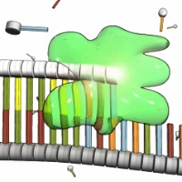
transcription / DNA transcription
Transcription is the process by which the information in a strand of DNA is copied into a new molecule of messenger RNA (mRNA). DNA safely and stably stores genetic material in the nuclei of cells as a reference, or template. Meanwhile, mRNA is comparable to a copy from a reference book because it carries the same information as DNA but is not used for long-term storage and can freely exit the nucleus. Although the mRNA contains the same information, it is not an identical copy of the DNA segment, because its sequence is complementary to the DNA template.
Transcription is carried out by an enzyme called RNA polymerase and a number of accessory proteins called transcription factors. Transcription factors can bind to specific DNA sequences called enhancer and promoter sequences in order to recruit RNA polymerase to an appropriate transcription site. Together, the transcription factors and RNA polymerase form a complex called the transcription initiation complex. This complex initiates transcription, and the RNA polymerase begins mRNA synthesis by matching complementary bases to the original DNA strand. The mRNA molecule is elongated and, once the strand is completely synthesized, transcription is terminated. The newly formed mRNA copies of the gene then serve as blueprints for protein synthesis during the process of translation.
Further Exploration
Concept Links for further exploration
translation
|
transcription unit
|
gene expression
|
frameshift mutation
|
nonsense mutation
|
RNA
|
DNA
|
enhancer
|
promoter
|
differentiation
|
gene expression
|
transcription factor
|
intron
|
exon
|
chromatin
|
histones
|
mutation
|
helicase
|
transcriptome
|
phosphate backbone
|
poly-A tail
|
nuclear pore
|
primase
|
TATA box
|
hairpin loop (mRNA)
|
DNA polymerase
|
mRNA
|
chromatin remodeling
|
cis-regulatory element
|
RNA polymerase
|
catabolite repression
|
methylation

















